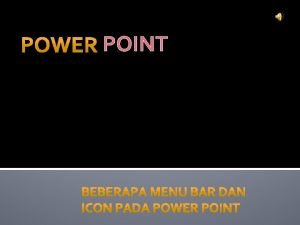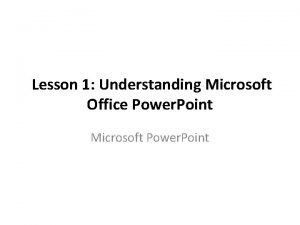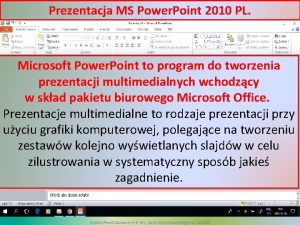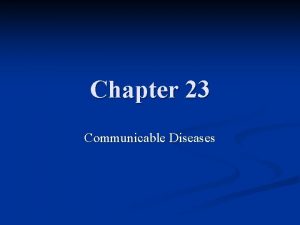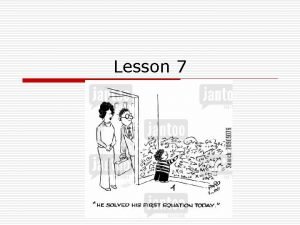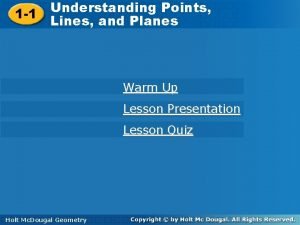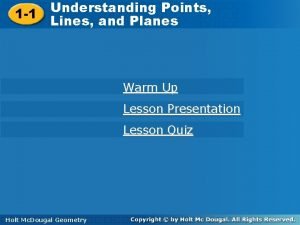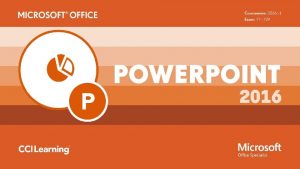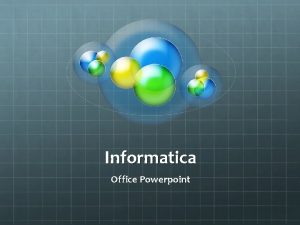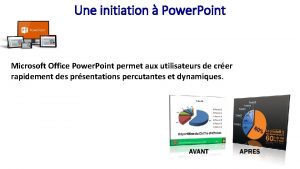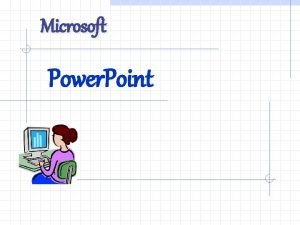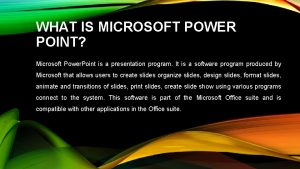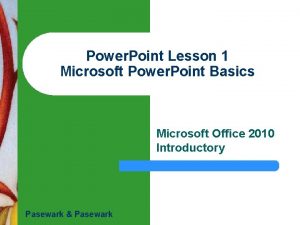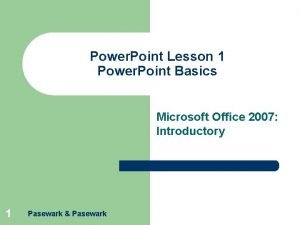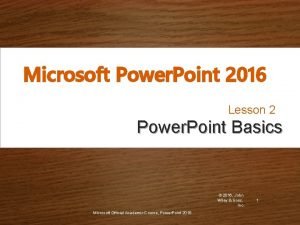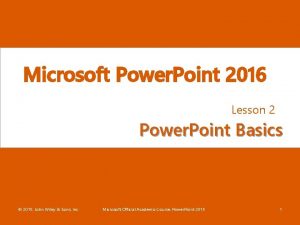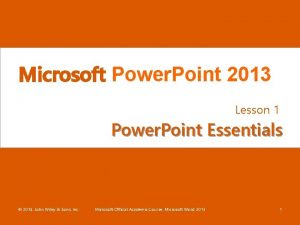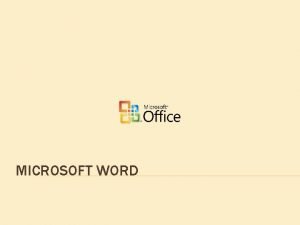Lesson 1 Understanding Microsoft Office Power Point Microsoft



















- Slides: 19

Lesson 1: Understanding Microsoft Office Power. Point Microsoft Power. Point

Learning Goals • The goal of this lesson is for students to successfully explore and describe the Power. Point window and to create a new blank presentation. The student will save the presentation, edit the presentation and properly exit the program.

Learning Objectives • On completion of this lesson, students will be able to do the following: – Start Microsoft Office Power. Point 2010 – Explore the Power. Point window – Create a new blank presentation – Navigate a presentation – Change text in the Outline/Slides pane – Reverse one or more actions – Change and add text in the slide pane – Change presentation views – Save a presentation

Uses of Power. Point • Uses of Power. Point: – Power. Point presentations consist of a number of individual pages or "slides". – Slides may contain text, graphics, movies, and other objects, which may be arranged freely. – The presentation can be printed, displayed live on a computer, or navigated through at the command of the presenter. http: //en. wikipedia. org/wiki/Microsoft_Power. Point

Parts of the Power. Point Window Slide Area – Shows a large view of the slide you are currently working on. c

What is a “slide”? • Individual pages in a Power. Point presentation • The default orientation of the slide is in landscape layout. (wider than tall) • Text, graphics and/or pictures are added to the slide to enhance its appeal.

Changing and Adding Text in the Slide Area • Click in an object to edit it. • Close Edit mode by clicking outside of the text object area.

Parts of a Power. Point Window c Slides Pane – Provides a miniature version of all of your slides in order. Outline Pane – Displays the content of each of your slides in the form of an outline.

What is the Outline Pane? • The Outline pane allows the user to concentrate on the content of the slide rather than the design aspect of the slide. • A slide can be edited in either the Outline tab or the slide pane.

Parts of the Power. Point Window Notes Area – Allows the presenter to add notes to the presentation. c

What are “speaker notes”? • Notes can be added to your Microsoft Power. Point presentation to jog your memory while you are delivering the presentation. • Power. Point notes are not viewable by members of your audience. Print a “Notes” page to refer to during the presentation.

Creating a Presentation • Power. Point opens with a blank presentation. • Create a NEW presentation under the FILE tab. • Start with a blank presentation, start with a theme, or start from a template.

Creating a New Slide • Slides can be placed at any position in the presentation. • By default, Power. Point has nine different slide layouts. • Insert a new slide immediately after the active slide by clicking the New Slide button on the Home Ribbon.

What are “handouts”? • You can print your presentation in the form of handouts — with one, two, three, four, six, or nine slides on a page — that your audience can use for future reference.

Changing Presentation Views • Change how you view your presentation using the options on the View Ribbon or using the view shortcuts in the lower right corner of the screen.

Presentation Views • Normal View – The main editing view, where you write and design your presentations. • Slide Sorter View- Gives you a view of your slides in thumbnail form. This view makes it easy for you to sort and organize the sequence of your slides as you create your presentation. Normal View Slide Sorter View

Presentation Views Reading View Slide Show View • Reading View – Use reading view to deliver your presentation not to an audience but instead to someone viewing your presentation on their own computer. • Slide Show View- Use Slide Show view to deliver your presentation to your audience. Slide Show view occupies the full computer screen.

Saving a Document • Why save a presentation instead of just recreating it? • Use “Save” to resave a document. • Use “Save As” to save a document with a new name, a new file type or in a new location. • Save frequently!! Power outages, computer problems, annoying sisters, curious dogs… any of these can cause you to lose a document! • Auto. Save and Auto. Recover might help in case of a saving emergency.

Choosing a File Name • You can save a file with up to 260 characters!! • Regardless, your file name should be as short and descriptive as possible. Why? ? ? • You can’t use the following characters in a file name: / ? : * " > < | • Get even more organized by creating folders and subfolders (folders within folders) to save groups of files in.
 Lesson 2 measurement and scientific tools
Lesson 2 measurement and scientific tools Custom slide show berfungsi untuk
Custom slide show berfungsi untuk Office power point adalah .. *
Office power point adalah .. * The real lesson 21
The real lesson 21 Power bi power point
Power bi power point Point point power
Point point power Bagaimana cara mengoperasikan microsoft powerpoint
Bagaimana cara mengoperasikan microsoft powerpoint Notes pane in powerpoint
Notes pane in powerpoint Que es microsoft power point
Que es microsoft power point Microsoft power point 2010
Microsoft power point 2010 Chapter 9 lesson 3 understanding violence
Chapter 9 lesson 3 understanding violence Chapter 23 lesson 1 understanding communicable diseases
Chapter 23 lesson 1 understanding communicable diseases Writing literal equations
Writing literal equations Chapter 4 lesson 1 understanding stress
Chapter 4 lesson 1 understanding stress Chapter 1 understanding health and wellness lesson 4
Chapter 1 understanding health and wellness lesson 4 Chapter 1 understanding health and wellness lesson 2
Chapter 1 understanding health and wellness lesson 2 Chapter 1 lesson 2 what affects your health
Chapter 1 lesson 2 what affects your health Understanding points lines and planes
Understanding points lines and planes Lesson 1-1 understanding points lines and planes
Lesson 1-1 understanding points lines and planes Classwork 1-1 point line plane answers
Classwork 1-1 point line plane answers

